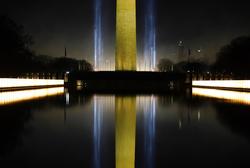 Fireworks are visible with COVID-19 memorial lights surrounding the Reflecting Pool and the Washington Monument in the background during the Celebrating America concert at the Lincoln Memorial in Washington, Jan 20, 2021, after President Joe Biden's inauguration. (PHOTO / AP)
Fireworks are visible with COVID-19 memorial lights surrounding the Reflecting Pool and the Washington Monument in the background during the Celebrating America concert at the Lincoln Memorial in Washington, Jan 20, 2021, after President Joe Biden's inauguration. (PHOTO / AP)
A day before the inauguration of the 46th president of the United States, I chose to walk to my office in downtown Washington to save time.
The heart of the District of Columbia used to beat with bustling businesses and travelers.
Not on this Tuesday.
Instead, the streets resonated with the rhythm of tactical boots worn by National Guard troops, as well as the soft sound of sneakers by a weary press corps covering the scene.
Much of the city was closed off as never before to prevent any repetition of the violent storming of the Capitol that led to five deaths two weeks ago.
Much of the city was closed off as never before to prevent any repetition of the violent storming of the Capitol that led to five deaths two weeks ago
High black fencing has been erected around the Capitol, around some businesses and other federal buildings throughout the city.
The number of National Guard troops brought in to defend the US capital-20,000 to 25,000-surpassed the number of US troops in the war theaters of Afghanistan, Iraq and Syria combined.
READ MORE: Washington turns into 'ghost town with soldiers' for US inauguration
As I walked along the barricaded buildings of 17th Street, I encountered small squads of hoodie-wearing National Guard troops, each laden with a backpack. They appeared to have just arrived for their mission.
Having heard that 12 of their comrades had been removed from security duties at the Capitol for "questionable behavior" in their past during security screening on Tuesday, I wondered if any of these troops were here to fill the vacancies.
I dispensed with my backpack, carrying only a camera and a palm-sized notebook to easily and quickly get through checkpoints. That was also for safety considerations.
At least nine journalists were physically assaulted by rioters during the Jan 6 mayhem, and the TV equipment of my colleagues covering the turmoil was damaged.
ALSO READ: Biden arrival in Washington framed by division, heavy security
Despite an alert for pre-inauguration violence, Tuesday, just like the weekend and Monday, was basically quiet and peaceful in the district thanks to the large presence of the National Guard and extra police.
There was, though, a small noisy protest on Black Life Matters Plaza near the White House.
Key plaza
The road was officially named by DC Mayor Muriel Bowser in early June during demonstrations against the killing of African-American George Floyd while in police custody in Minneapolis on May 25.
The plaza has become a gathering place for people to vent against racial injustice, police brutality and now "domestic terrorists".
Almost all the shops and restaurants on nearby streets were boarded up in case of pre-inauguration violence
A white woman waving small flags was singing religious and patriotic American songs in front of a painted portrait of civil rights icon Martin Luther King Jr.
She was approached and interrupted by a young black man as people gathered around them.
The counter-protester, waving a "Black Life Matters" flag on one hand and holding a loudspeaker in another, stood just inches from the woman.
They were at an impasse-as neither refused to move. There was an exchange of words among passersby, who seemed to be at odds with each other about the protest.
Almost all the shops and restaurants on nearby streets were boarded up in case of pre-inauguration violence. Last summer, violent confrontations flared during anti-racism protests.
The only difference between then and now is that the fortifying of the nation's capital seems to be more creative. At one spot, a portrait of King seemed to be staring at some of the plywood.
Around the National Press Building on 14th Street, where several international press outlets have offices, the street on the building's west side was off limits to the public. Rows of soldiers were lined up near a barricade.
Troops were also outside a restaurant across from the press building, turning the area into sort of an open-air barracks.
I remember talking to Cal Jillson, a political scientist and historian at Southern Methodist University in Dallas, about the unprecedented show of force in the district and state capitals around the US.
"Once Biden is inaugurated and tensions begin to abate, it will be important to get the barriers down as soon as is responsibly possible," he said.
I went to the office to get a new face mask. What I thought would be a faster walk turned out to take three times as long compared to a normal day.
But then it was anything but a normal day.


